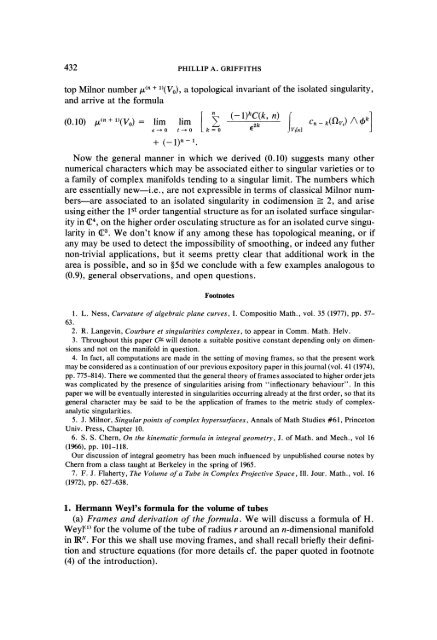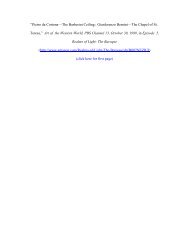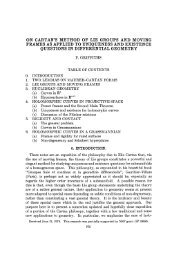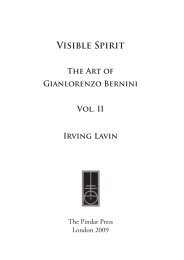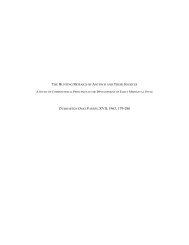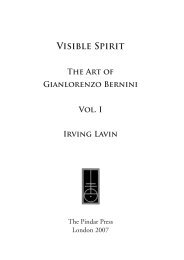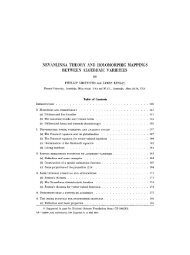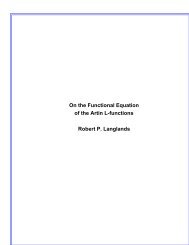View PDF - Project Euclid
View PDF - Project Euclid
View PDF - Project Euclid
You also want an ePaper? Increase the reach of your titles
YUMPU automatically turns print PDFs into web optimized ePapers that Google loves.
432 PHILLIP A. GRIFFITHS<br />
top Milnor number/.,(n + 1)(V0) a topological invariant of the isolated singularity,<br />
and arrive at the formula<br />
(O. lO) /.t(n+l)(Vo)= lim lim ( (-1)C(k’n)e<br />
0 t--)O k=O<br />
+ (--1)n-i.<br />
Now the general manner in which we derived (0.10) suggests many other<br />
numerical characters which may be associated either to singular varieties or to<br />
a family of complex manifolds tending to a singular limit. The numbers which<br />
are essentially new--i.e., are not expressible in terms of classical Milnor numbers-are<br />
associated to an isolated singularity in codimension => 2, and arise<br />
using either the st order tangential structure as for an isolated surface singularity<br />
in 4, on the higher order osculating structure as for an isolated curve singularity<br />
in (3. We don’t know if any among these has topological meaning, or if<br />
any may be used to detect the impossibility of smoothing, or indeed any futher<br />
non-trivial applications, but it seems pretty clear that additional work in the<br />
area is possible, and so in 5d we conclude with a few examples analogous to<br />
(0.9), general observations, and open questions.<br />
Footnotes<br />
1. L. Ness, Curvature of algebraic plane curves, I. Compositio Math., vol. 35 (1977), pp. 57-<br />
63.<br />
2. R. Langevin, Courbure et singularities complexes, to appear in Comm. Math. Helv.<br />
3. Throughout this paper C will denote a suitable positive constant depending only on dimensions<br />
and not on the manifold in question.<br />
4. In fact, all computations are made in the setting of moving frames, so that the present work<br />
may be considered as a continuation of our previous expository paper in this journal (vol. 41 (1974),<br />
pp. 775-814). There we commented that the general theory of frames associated to higher order jets<br />
was complicated by the presence of singularities arising from "inflectionary behaviour". In this<br />
paper we will be eventually interested in singularities occurring already at the first order, so that its<br />
general character may be said to be the application of frames to the metric study of complexanalytic<br />
singularities.<br />
5. J. Milnor, Singular points of complex hypersurfaces, Annals of Math Studies #61, Princeton<br />
Univ. Press, Chapter 10.<br />
6. S. S. Chern, On the kinematic formula in integral geometry, J. of Math. and Mech., vol 16<br />
(1966), pp. 101-118.<br />
Our discussion of integral geometry has been much influenced by unpublished course notes by<br />
Chern from a class taught at Berkeley in the spring of 1965.<br />
7. F. J. Flaherty, The Volume of a Tube in Complex <strong>Project</strong>ive Space, Ill. Jour. Math., vol. 16<br />
(1972), pp. 627-638.<br />
1. Hermann Weyl’s formula for the volume of tubes<br />
(a) Frames and derivation of the formula. We will discuss a formula of H.<br />
Weyl


